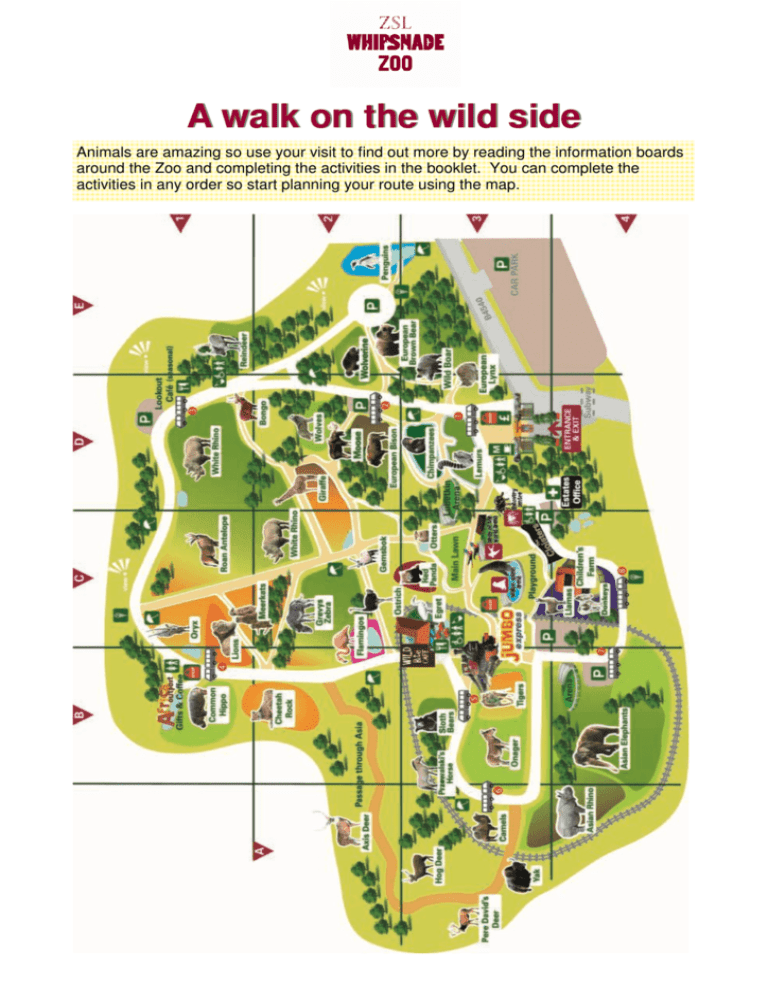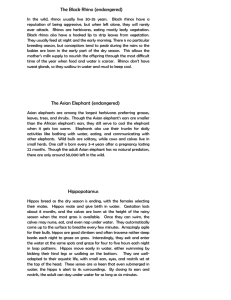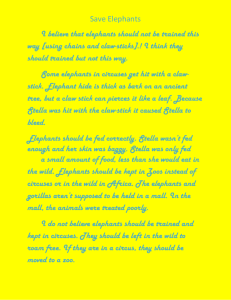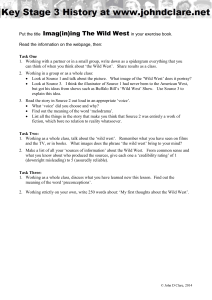Walk on wild side trail answers
advertisement

A walk on the wild side Animals are amazing so use your visit to find out more by reading the information boards around the Zoo and completing the activities in the booklet. You can complete the activities in any order so start planning your route using the map. A walk on the wild side Animal communication Animals communicate with each other in lots of different ways and for lots of different reasons. Keep an eye out for animals communicating with each other as you go round the Zoo. Things to do and think about: Spend a couple of minutes thinking about how different animals communicate with each other and write down as many as possible. Sounds (Auditory) Body language and facial expressions, colour of skin, feathers etc. (Visual) • Pheromones (Olfactory) • Touch (Tactile) • • This list is not exhaustive Chimpanzees Things to do and think about: • Find the chimp enclosure and study the chimps. Can you see them communicating with each other? • Go inside the chimp house to see their indoor play area. Read the information boards inside to find out more about chimp communication and use of tools. • Chimpanzees are highly intelligent and often use items like sticks as tools. List 3 ways in which chimpanzee use sticks. 1. Getting food that is out of reach (grappling hook). 2. Getting termites or ants out of their nest. 3. Extracting honey from a bees nest. • Study the information about chimp facial expressions. Draw a mouth onto the chimp picture to show a frustrated or nervous facial expression. Wolverine The name wolverine probably brings to mind a cartoon and film character rather than this furry creature. Wolverines are found in Russia Scandinavia, Canada and parts of the USA e.g. Alaska. This species is threatened by habitat loss and persecution by humans in the wild. Wolverines sometime attack livestock and so are hunted by farmers. Wolverine have powerful jaws and sharp teeth which allow them to eat frozen carrion (dead animals). Wolverine are very agile and are able to climb trees and swim. Things to do and think about: • The wolverine is the largest member of which family? • The weasel family Find out what type of habitat the wolverine lives in and what it eats. The wolverine is found in Arctic tundra and taiga habitats. Wolverine are scavengers feeding on carrion. A walk on the wild side Penguins There are 17 species of penguin all of which are found in the southern hemisphere. The largest species is the Emperor penguin which can reach 130cm in height. The smallest species is the little or blue penguin which is usually around 35cm tall. Penguins feed on fish, krill (small, shrimplike creatures) and squid. They catch their food in the water and so have to be good swimmers. Penguins are fast and agile in the water but don’t move so easily or gracefully on land. Things to do and think about: Find out which species of penguin live at Whipsnade. • Black-footed penguins (also known as African penguins) Penguins are well adapted to life in the water. Watch them swimming in their pool and use the information around their enclosure to find out more. Make a list of their adaptations. Legs – used for steering when they are swimming. wings – are flat and used to propel them underwater. Tail – acts as a rudder. Body – the torpedo shape allows them to move quickly through the water. Eyes – they have great vision underwater – brilliant for catching fish. Feathers – act as a waterproof layer which traps air next to their bodies insulating them from the cold. Fat deposits – these deposits of fat help to insulate them from the cold. White rhino For a long time white rhinos have been threatened with extinction in the wild due to hunting. Rhinos are hunted for their horns which are ground up and used in traditional oriental medicines. To ensure the survival of rhinos zoos have taken them into captivity to protect and breed them. There have been white rhinos at Whipsnade since the late 1960’s and we have had a very successful breeding programme. There have been over 55 calves born at Whipsnade since the first white rhinos arrived. Things to do and think about: • All of the rhinos have names. There are who’s who boards around the enclosure which will help you to identify the individuals. Who can you spot? Will be different for each student • Can you see any calves in the paddock? Will be different for each student A walk on the wild side Cheetahs Cheetahs are famous for being the fastest land animal in the world. They can reach speeds of up to 70mph. They can only maintain these high speeds for a short time and most chases will be over in less than a minute. Things to do and think about: Cheetahs are built for speed. They have a number of adaptations that help them to run fast. Note down as many adaptations as you can. Have a look at the information in Cheetah Rock to help you. Claws - acts like the studs on a football boot Tail - helps the animal balance when changing direction Flexible spine - gives the animal a long stride meaning they can cover a large distance in one stride Hippos Hippos spend most of their day in the water because they don’t have sweat glands and find it hard to keep cool any other way. They come on to land at night to feed mainly on grass. Hippos can stay mostly submerged in the water but still be aware of what is going on around them due to the positioning of their senses (eyes, nostrils and ears). Things to do and think about: • How do hippos mark their territory? Hippos mark their territory by defecating and using their tail to spread it around. They will complete this behaviour both on land and in the water. • Although hippos don’t sweat they do have glands in the skin that secrete a sticky substance that is has a number of properties. Can you find out what this substance can do? The sticky substance that the hippos secrete from glands in their skin is pink in colour and it acts as a suncream and an antiseptic. A walk on the wild side Sloth bear Sloth bears are found in a wide variety of habitats from grasslands to forests in Nepal, Bhutan, Bangladesh, India and Sri Lanka. They are active day and night searching for food under logs. Sloth bears eat insects like termites and ants. They break into hard termite mounds using their long, sharp claws and strong forelegs. They then suck up the termites through a gap in their front teeth. They will also Things to do and think about break open logs and climb trees in the search for • Have a good look at the sloth bear food. Sloth bears love honey and will endure enclosure. What things are there for the bee stings just to get some honeycomb. bears to use and play with. Tyres, mock termite mound, logs, Sloth bears, like lots of other animals, would branches, climbing frame, boxes, balls and spend a great deal of time out in the wild looking pipes. for food. In a zoo animals don’t have to worry about finding enough food as their keepers Keeper put new items in regularly so provides it. Therefore it is really important that students might have spotted other things as zoos make the enclosures interesting for the well. animals to stop them from getting bored. Asian rhino The Asian rhinos is vulnerable in the wild due to hunting for their horn and habitat loss. Rhino horn is made from keratin; the same protein that makes up our hair and fingernails. ZSL has a conservation programme out in Nepal to protect this species in wild. Things to do and think about • Find out more about ZSL’s conservation project in Nepal. What are the aims of the project? The projects aims to increase the population and conserve the grasslands they live in. By saving the grasslands ZSL is also helping to protect other species that inhabit the area e.g. Bengal tigers. Gaur Gaur are vulnerable in the wild due to hunting, habitat loss and diseases like foot and mouth. They are hunted for their impressive horns which both males and females have. The horns can reach 80cm in length. Gaur are related to domestic cattle and are one of the largest species of wild cattle. Gaur can reach over 2 metres in height at the shoulder. Things to do and think about • Where would you find gaur in the wild? Gaur live in the upland forests and grassy glades in Indian, Nepal, Myanmar and Thailand. A walk on the wild side Asian elephants Asian elephant Asian elephants are considered Endangered in the wild due to habitat loss and hunting. The ivory tusks elephants are famous for are in fact modified incisor teeth. Usually it is only the male Asian elephants that have visible tusks. Females have very small tusks called tushes which are not normally visible. Elephants’ trunks are an amazing tool that isn’t just used to put food into their mouths. It can be used for picking up water and squirting it into their mouths, throwing sand or water over their body and even for delicate tasks like scratching an eye. Females and calves live in small groups, while male elephants are solitary. Things to do and think about • Elephants can communicate over large distances which is especially useful if they are in dense forests and can’t see other members of their herd. Describe how they can communicate over long distances. Can’t see the elephants? They maybe out on a walk. The adult female elephants and calves go for daily walks around the Zoo to give them exercise and a change of scenery. Elephants can communicate using sounds some of which humans can’t hear. These are called infrasounds and are particularly useful for long distance communication. Infrasound is low frequency which the elephants can feel through their feet as the sound waves through the ground. Sealions Background Californian sealions live around north and south America, Japan and Australia where surface sea temperatures vary between 5°C and 20°C. Sealions have a layer of blubber under the skin and waterproof fur which traps air helping to insulate the animal from the cold. Sealions can swim up to 30mph although they usually cruise at speeds of 10 to 11mph. They use their strong front flippers for propulsion while their back flippers are used for steering. Sealions are very intelligent and can learn very quickly. The sealions at Whipsnade Zoo are trained and from April to October there is a sealion demonstration. Things to do and think about: • Go to the sealion demonstration if you can. Times are shown in the day planner. • Find out why is it important for the keepers to train the sealions? It is important to train the sealions for their general day to day care and veterinary treatment. A walk on the wild side Red panda Red pandas are found in the Himalayas and mountainous regions of northern Myanmar and western China. They have thick coats to provide warmth and even their feet are covered in hair. Red pandas are suited to life in the trees and are much more agile in the trees than on the ground. Things to do and think about: • The red panda is not related to the giant panda. In fact the giant panda was discovered over 40 years after the red panda. Find out when the red panda was first discovered? The red panda was discovered in 1825. The red panda is crepuscular, but what does this mean? Crepuscular means that the animal is mainly active at dawn and dusk. • Giraffe Giraffes are the tallest land animal. Males can reach around 5.3 metres tall. That’s taller than a double decker bus. Giraffes have a prehensile, black tongue which can measure up to 45cm in length. They use their tongues to wrap around leaves on acacia trees, the giraffes favourite food. Giraffes can eat up to 134kg of leaves a day. Giraffes have two bone-like structures on their heads and a bump on their forehead covered in skin and hair. Males use these for fighting. Males will swing their heads at each other like clubs and a well placed blow can knock a giraffe off balance. Things to do and think about: • A baby giraffe is called a calf. When they are born they about 170cm (5ft 7in) tall. How tall are you and are you taller than a newborn calf? This will be different for every student • Giraffes are famous for their long neck and legs. An adult giraffe’s neck is about 2.4m in length but can you find out how many bones there are in their neck? Giraffe have 7 vertebra in their neck, the same as humans A walk on the wild side The Discovery Centre The Discovery Centre houses all of the reptiles, amphibians, fish and invertebrates at the Zoo. There are lots of weird and wonderful creatures in the Discovery Centre including axolotl and snake-necked turtles. Can you locate the species mentioned below and find out more about them? Green and black poison arrow frog Things to do and think about • These frogs are brightly coloured, but why. What sort of message are these frogs communicating to other animals? The bright colours are a warning to predators that they are poisonous. Matamata turtle The matamata turtle is found in stagnant pools in Brazil, Guyana and Trinidad. These turtles lie camouflaged on the bottom and wait for their prey. When prey comes close enough the turtle will quickly open its mouth and extend its neck. Water will rush in to the mouth along with the prey. The turtle then spits out the water and swallows the prey whole. Matamata turtles feed on fish and invertebrates. Things to do and think about • Can you spot the matamata in their pool? • How would you describe this species to someone who had never seen a matamata turtle before? This will be different for each student Things to do and think about There are lots of species on the planet that you may never have heard of before. Make a list of any species in the Discovery Centre that are new to you? This will be different for each student White-faced saki monkey The white-faced saki monkeys show sexual dimorphism, which means that the two sexes look different from each other. The male saki monkey has a white face and a black body while the female is brownish grey. Things to do and think about • Can you think of other species that shows sexual dimorphism? (have a look around the rest of the Zoo) Peafowl, lion, kudu and Philippine sailfin lizard.






